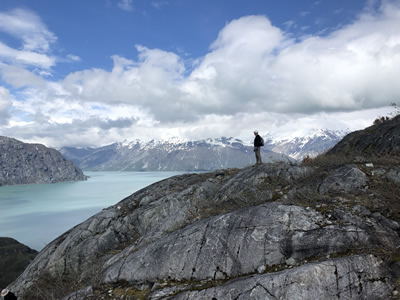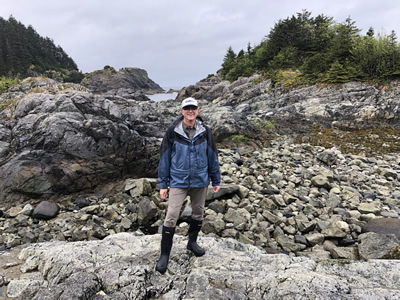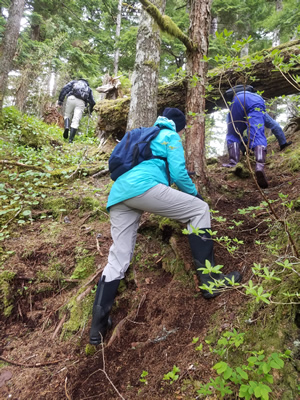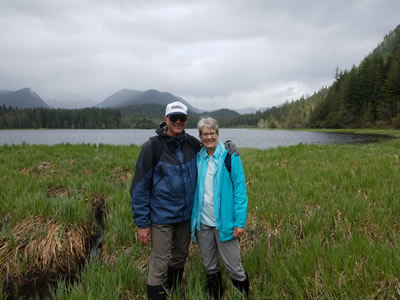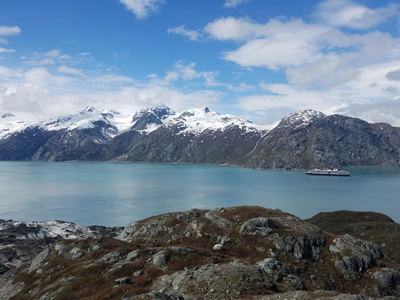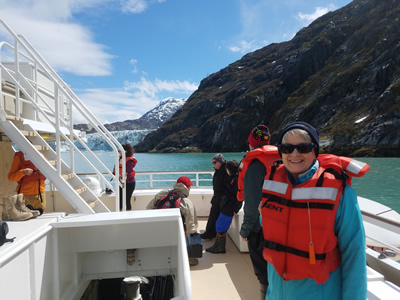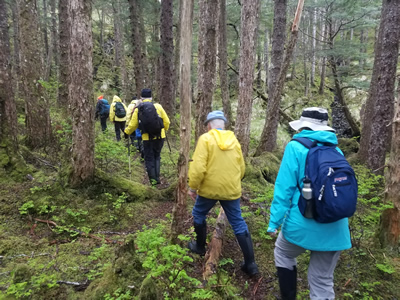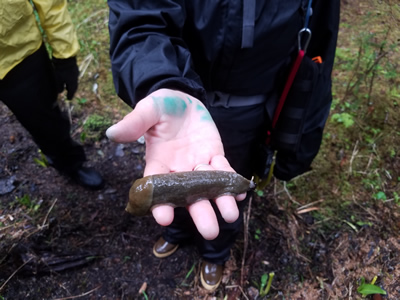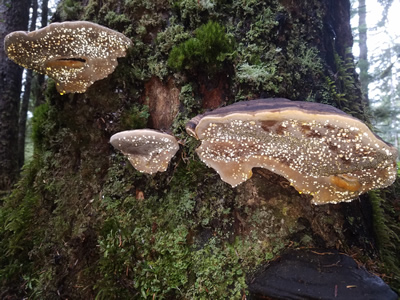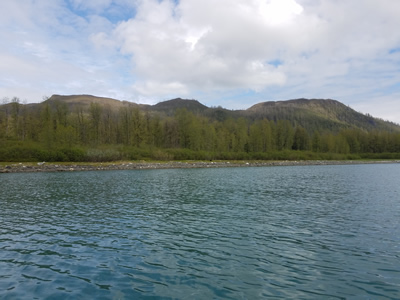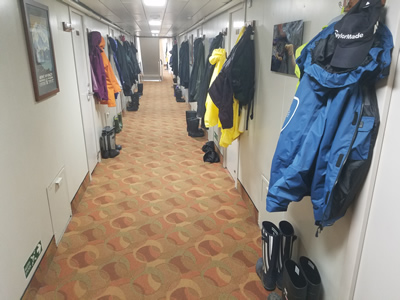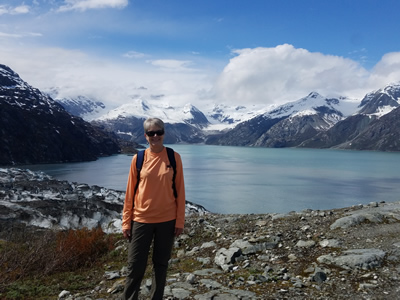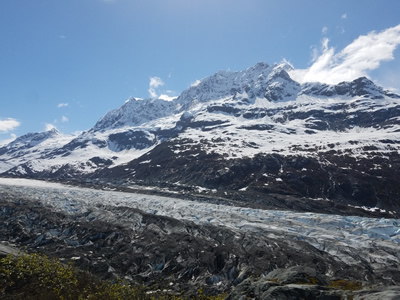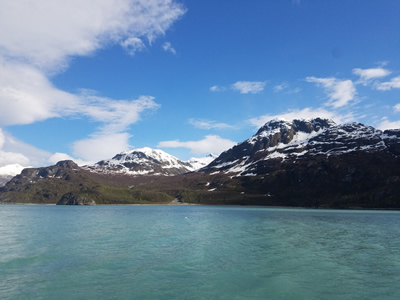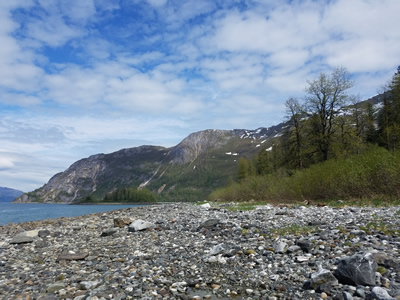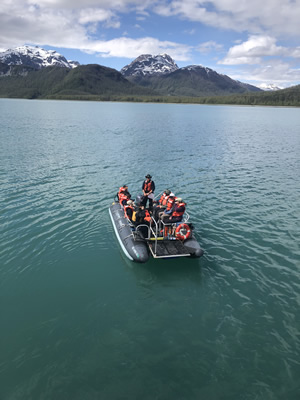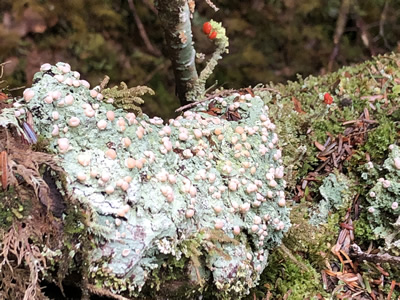Hiking on our Uncruise
When Sandy and I went to Southeast Alaska, we signed up for a week-long cruise. It really is the best way to see the area. What we picked wasn't your typical Inside Passage cruise though. We chose a trip from a company called Uncruise, specifically their Glacier Bay National Park Adventure Cruise. It didn't travel from Seattle to Alaska, seeing the scenery along the way. This trip started and ended in Juneau and spent an entire week exploring Glacier Bay and the surrounding area. Instead of traveling two thousand miles along the coast, we never went more than a hundred miles from Juneau.
We didn't travel on a floating city that carried thousands of people either. There was no swimming pool or night club or casino onboard. Our boat only carried fifty passengers and twenty five crew members. Because we were on a small ship, we could explore tiny inlets and coves, going places that the big ships couldn't reach.
Most important, it was an "adventure cruise". It was oriented towards physical activities, like hiking and kayaking. Unlike the big cruise ship lines, where people spend most of their days ashore in various towns checking out the shops and bars and restaurants, we would be spending our days exploring the wilderness. We would be active rather than passive, participants not just passengers.
Like most cruise ships, usually we would travel at night. In the morning we would be anchored in some remote spot. Most days there would be a morning activity and an afternoon activity (with that all important break back on board for lunch in between). Usually there were three activities. One would be on land, either a trail hike, or since trails are rare in Alaska, a bushwhack. There would also be kayaking for those who were more comfortable on the water. Finally there would be a skiff tour for those who didn't feel like working too hard and just wanted to go for a (scenic) ride.
Sandy and I are hikers so we always picked the land option. We have a lot of hiking experience but Southeast Alaska turned out to be a lot different than the mountain areas where we've traveled before. Most of it is truely remote, pure wilderness and there just are not many trails.
Some days we were lucky and were able to do trail hikes. One of those days was when we stopped in Bartlett Cove. It's where Glacier Bay Lodge is located, along with the headquarters for Glacier Bay National Park. It was kind of a preview trip for us because we were booked to return there on our own for a few days after the cruise and stay at the lodge. There was a small network of trails around Bartlett Cove, the only maintained trails in the park, which we eventually got to know quite well. I'll cover that visit in a later post.
Our only other trail hike was in Pavlof Harbor. From our dropoff point we followed a real hiking trail, not a game trail, along Pavlof Creek to a small waterfall. Years ago it was the site of a salmon cannery. Although there isn't any trace left of the buildings, there was a lot of old rusty heavy equipment lying beside the stream. Now the area is an Alaska state park. There is still a major salmon run in the creek but only the bears show up to catch the fish. Lots of bears though, so many that access to the park is limited from July tthrough September. I'm not sure if that is to protect the bears from the people or vice versa. When we were there in mid May we didn't see any bears near the falls, although we did see one on the shore across the bay from us.
Beyond the falls the trail continued to Pavlof Lake, a fairly large lake with a pretty backdrop of mountains. I think. Unfortunately it was a cloudy day which cut down on the view. All around the lake the shoreline was a grassy marsh - rubber boots were a necessity on this hike. Although it looked like it would be a great place to spot wildlife, we waited at the lake shore for quite a while and didn't see anything. Apparently the moose are wimps and only come out on sunny days.
Other days there were no trails at all. Sometimes we would take the path of least resistance and walk along the shoreline. It was always scenic next to the water and it was interesting to look among the rocks and tidepools. We found a lot of beautiful shells and brought a few of them back with us. We weren't the only ones who thought it was easier to walk near the water. We often saw bears doing the same, although usually we saw them from the boat.
Other times we were bold and ventured into the rainforest. I have done a lot of mountaineering so I'm used to cross country travel. In places like Idaho it's pretty easy. When climbing mountains I'm above timberline much of the time. Lower down the forests are open and finding a way through them isn't difficult. That's not how it is in Southeast Alaska which is covered in dense rainforest. That meant that every step of the way we were climbing over logs and pushing through underbrush.
Very dense underbrush. Usually it was berry bushes, which was bad enough, but sometimes it was devil's club, which is downright mean. It's covered with barbed thorns and seems to grow in the worst possible places. Anytime you reached out to grab a branch or a stalk to get support or keep your balance, odds were that it would turn out to be devil's club. And it hurt.
I learned a long time ago to wear light gloves to protect my hands when I'm scrambling or bushwhacking, anytime I'm using my hands a lot. I wear them even when my hands aren't cold. Sandy does too. So the devil's club never really got us, although it did get some of the other people on our hikes. Never mind the grizzly bears. Devil's club was the real threat when we were bushwhacking.
Our hikes were always led by one of the guides from the boat. We would assemble at 300 aft when we heard the PA annoucement calling us. From there we would get on one of the skiffs which would then shuttle us to the shore. Our groups usually had six or eight people because that was how many people the skiffs could carry. After being dropped off on shore we would spend two to four hours doing our trail hike or bushwhack. Then we would return to shore and radio for a pickup.
This was Alaska so the hikes went out regardless of weather. Normally Sandy and I are fair weather hikers. Our home mountains in Idaho generally have nice weather during the summer and fall so we can afford to be selective. In Alaska nice days are rare and clouds, fog and rain occur often. We knew about the climate before we left on our trip and brought along appropriate clothes and rain gear for hiking in wet weather. Even when it was raining we went along. We figured that there was no sense going all the way to Alaska and then just sitting in our tiny room on the boat because we didn't want to get wet.
Everyone on the trip joked about the rainy weather in Southeast Alaska. While we were hiking we referred to the rain as "liquid sunshine". One day when the weather was actually quite nice and there was a lot of blue sky, we said that we were experiencing "major cloud failure".
One thing that was different about hiking on this trip compared to what we are used to was footgear. In Alaska, when you hike you wear rubber boots. Period. The preferred brand is called XtraTuff. Sandy and I had read about it before the trip so we bought boots in Boise and brought them with us. It was a real pain because they took up a lot of space in our luggage. As we were packing I kept wondering if it was really worth taking them along. It turns out that it was a good thing that we did. Rubber boots rather than conventional hiking boots are a necessity. When we got out of the boat to go to shore, we often had to step into a foot or more of water. Whether on a trail or bushwacking, we often had to go through water or mud several inches deep. In hiking boots it would have been a disaster but with our rubber boots we just tromped right through the water and mud without a second thought.
Although we were prepared for hiking in the rain we were hoping for good weather. We've had good luck in the past hiking in rainy places like New Zealand. But Alaska didn't disappoint us. We got multiple chances to hike in the rain. It was usually light, soaking drizzles rather than downpours so it wasn't that bad. It was steady though. But hey, the rain just adds to the ambience when you are hiking through the rainforest.
Because we had some rainy days, with clouds and fog to go with it, on those days we focused more attention on the rainforest than the scenery. On our very first hike on George Island, our first wildlife sighting wasn't a moose or a grizzly bear but a giant slug. We learned to spot lichen, like witch's cup, witch's butter, witch's beard and our favorite, fairy puke. Travis, one of the hiking guides, taught us that if we took a flash picture of the underside of bears bread (another large fungus) that the drops of water on its underside created a really neat effect. We learned to really apperciate the microenvironment in the rain forest.
We did see some big wild life as well. There were several times that we saw grizzly bears from the boat as they were walking along the shore. On one hike a bear was just down the beach from us when we were picked up. On the way back to the mothership the skiff went by it so we could get a look. Another time there was a bear further down the shore from us. The crew on the boat called our guide on the radio and told her where it was, so we changed course to avoid it. And once a group ahead of us turned back saying that they had seen a bear. Our guide tried to approach it cautiously but we never found it. By the time we got there it had already left. But bottom line, on this trip we never really got a close up sighting of any big mammals, either bear or moose. I didn't have a telephoto lens. I was just using my Galaxy S7 to take pictures so about the best I can do is point to a picture and say "that dark pixel in the middle is a grizzly bear". We have seen a lot more bears in the past on trips to the Canandian Rockies.
There are a lot of bears in Southeastern Alaska. Admirality Island has the highest density of brown bears in North America. Nearby Baranof and Chicagof Islands (together with Admirality they are known locally as the ABC islands) also have large bear populations. Almost all of the three islands are designated Wilderness areas. With berry bushes that seem to grow everywhere and massive salmon runs in the rivers and streams, it's ideal habitat for bears.
As a side note, one thing that I learned on this trip is that grizzly bears have been reclassified so that they are no longer a separate species. They are now considered a subspecies of brown bear. So before the trip I was reading a lot about brown bears in the area and thinking, no big deal. Brown bears aren't so bad. Well with the new nomenclature, some of them are. I will admit that grizzly bears make me nervous.
They made our hiking guides even more nervous. They took all the normal precautions when we were hiking, which given that there were a lot of bears around seemed very reasonable. They carried bear spray. They made a lot of noise while we hiked. (Each guide had their own unique "bear cry" that they used to alert bears that we were coming. Some of them were pretty funny.) They kept the group together. But to me they seemed overly paranoid. They went to great lengths to make sure none of our groups got anywhere close to a bear. Since we were always in a group of eight or ten people, that seemed to be overly cautious. I'm not an expert but I have read a lot about bear attacks and I don't think there is any recorded incident in North America of a bear attacking a group that large. So I think that we were pretty safe. Maybe they were just being extra cautious since they felt responsible for everyone. Maybe they were just worried that if we did get close to a bear someone in the group would do something stupid.
Which might have been a valid concern. The one time that we were fairly close to a bear and the guide told everyone to stay close together, one lady did wander off on her own to get a picture. When she was chastized by the guide she replied that she thought the bear was far away and it didn't matter that she was separated from the group. Sandy and I just shook our heads. There is always That Person in every group. I guess I could understand why the guides might be extra cautious. It didn't matter though because there were no close encounters with bears anytime on the trip.
All we had to worry about was the weather. Although we were being tough and hiking even when it rained, the guides usually went easy on us those days. Instead of two hikes, when it was raining we would usually only do one. On the first day of the trip, we spent the whole morning in orientation talks so that we only had time for one hike after lunch.
On another day, after a wet morning hike, we stayed on the ship all afternoon, cruising through Glacier Bay checking out "wildlife hot spots" - locations in the park famous for viewing wildlife. We passed by South Marble Island, where we could see dozens, maybe hundreds of Stellar sea lions that had climbed out of the water to lie on top of the rocks (and each other). We also sailed by Gloomy Knob, where a sheer rock face rose directly out of the sea. Mountain goats scrambled all over the steep cliff where they were safe from any predators.
At the end of the day you could always tell what the weather had been like without ever having gone outside. You just had to look down the ship's main hallway. If it had rained it would be lined for its entire length with everyone's wet jackets and boots, hung up directly outside of their cabins to dry off. It worked pretty well though. The next morning our stuff was always dry and ready to go again.
Of course it didn't rain all of the time. In fact, it didn't rain most of the time, although we often had clouds, especially over the mountains. We did have one really beautiful day during our cruise and it was perfectly timed for when we were at the head of Glacier Bay.
That afternoon we hiked up a long rocky ridge that ran alongside of Lamplugh Glacier. From the water's edge, where huge ice chunks broke off into the bay, the glacier stretched back for eight miles into the heart of the Fairweather Range. Directly across from us rose 6,155 ft Mt. Cooper, it's summit completely clear. The sky was blue and there was warm sunshine. For a change we could hike in tshirts instead of our rain jackets. It was also the only time we could wear regular hiking boots, and we changed into them as soon as we stepped out of the water onto the rocky beach. Since the tide can rise many feet in Glacier Bay, we had to climb up a series of wet, very slippery rock slabs carrying our rubber boots to reach a place where we could safely stash them until we returned.
There was no forest here. The glaciers had recently receded and only low brushy plants had colonized the area. That meant there were no logs to climb over or devil's club to worry about. It was still a tough hike though. The brush was low but thick. Going up the ridge there was either loose gravel or steep rock slabs. It was hard work but we climbed up to a local high point that gave us a fantastic view over the entire upper end of Glacier Bay. From the ship the ridge hadn't looked high at all. But the scale of the place was deceiving and we had climbed at least a thousand feet above the bay.
It was an unbelievable sight, looking out over Glacier Bay, seeing the tidewater glaciers coming right down to the ocean. The mountains rose directly out of the water, a wilderness that stretched as far as we could see into the distance. A wilderness in every direction with no cities or towns, no people, no roads and no trails. It was an amazing, primeval place.
Far below us we could see a giant cruise ship sailing up the bay. It was completely dwarfed by the scale of the landscape all around it. Our own ship was visible but barely, just a tiny spec in the distance. We took advantage of the fine weather and took a long time enjoying the view. Eventually we headed back down, taking our time, descending slowly, pausing frequently to look out at the scenery and taking lots of pictures.
This was definitely the best of the hikes that we did during the cruise. I enjoyed them all, they were all different, but the scenery on this hike made it the highlight of the trip.
I also have to admit that just as a hiking trip, the cruise didn't rate as highly as other trips that I've done. There was a lot bad weather. The hikes didn't always lead to scenic destinations, like a lake or pass or mountaintop. For pure hiking, I've would say that my treks in the Himalayas and Andes were better. So were hiking trips that I have done to places like the Alps or the Canadian Rockies or even some national parks in the US.
But overall the trip to Southeastern Alaska was tremendous. It's a place that is different from any other mountains that I had been to before. It's a true wilderness. After our week-long cruise, that wasn't just an academic concept but a strong, visceral feeling. We had sailed many miles and seen numerous mountains and valleys. After landing we were often limited to just walking along the shore, unable to penetrate the dense forest. I saw for myself that unlike other mountain areas, here trails were few and short. When we did bushwhack into the forest, it would take us half a day of very hard work to travel less than a mile. There was no easy way into the wilderness.
That's why it was amazing to stand high on the ridge above Lamplugh Glacier and see nearly endless rows of mountains stretching off into the distance. In the lower forty eight, in the wildest places in Idaho or Montana or Wyoming, you might be able to get twenty miles away from a road. Here there were fifty miles between us and the nearest road, an incredible fact in the twenty first century. And after our bushwhacking experiences, I knew that traveling those intervening miles would not be measured in miles per hour, but hours per mile. It sounds trite, but looking out over such a huge, wild, primitive landscape was truely mindblowing. So while the hiking itself wasn't the best that I have ever done, the integrated experience of Alaska was awesome and the hiking was an important part of that.
It was a great trip.
